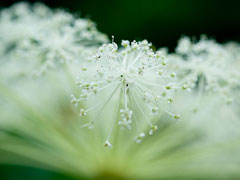 |
|
http://www.flickr.com/photos/43444131@N00/2769690211/ |
 |
|
Translate this page:
Summary
Physical Characteristics

 Angelica_pubescens is a PERENNIAL growing to 1.8 m (6ft).
Angelica_pubescens is a PERENNIAL growing to 1.8 m (6ft).
See above for USDA hardiness. It is hardy to UK zone 7 and is not frost tender. It is in flower from July to August. The species is hermaphrodite (has both male and female organs) and is pollinated by Insects. The plant is self-fertile.
Suitable for: light (sandy), medium (loamy) and heavy (clay) soils. Suitable pH: mildly acid, neutral and basic (mildly alkaline) soils. It can grow in semi-shade (light woodland) or no shade. It prefers moist soil.
UK Hardiness Map
US Hardiness Map
Synonyms
Plant Habitats
Edible Uses
Leaves - cooked[105, 177].
References More on Edible Uses
Medicinal Uses
Plants For A Future can not take any responsibility for any adverse effects from the use of plants. Always seek advice from a professional before using a plant medicinally.
The roots and rhizomes are anodyne, anti-inflammatory, antirheumatic, carminative, nervine and vasodilator[147, 176]. A decoction is used to promote menstruation[218], to treat rheumatoid arthritis, rheumatism, headache, toothache and abscesses[147]. This herb is used medicinally in the same ways as A. dahurica (Bai Zhi)[254]. These uses are as follows:- Bai Zhi has been used for thousands of years in Chinese herbal medicine where it is used as a sweat-inducing herb to counter harmful external influences[254]. Bai Zhi is contraindicated for pregnant women[254]. The root is analgesic, anodyne, antibacterial, antidote, carminative, diaphoretic, diuretic, poultice and stimulant[176, 178, 218]. It is used in the treatment of frontal headache, rhinitis, boils, carbuncles and skin diseases[176]. It appears to be of value in treating the facial pain of trigeminal neuralgia[254]. Small quantities of angelicotoxin, one of the active ingredients in the root, have an excitatory effect on the respiratory centre, central nervous system and vasculomotor centre. It increases the rate of respiration, increases blood pressure, decreases the pulse, increases the secretion of saliva and induces vomiting[176]. In large doses it can cause convulsions and generalized paralysis[176].
References More on Medicinal Uses
The Bookshop: Edible Plant Books
Our Latest books on Perennial Plants For Food Forests and Permaculture Gardens in paperback or digital formats.

Edible Tropical Plants
Food Forest Plants for Hotter Conditions: 250+ Plants For Tropical Food Forests & Permaculture Gardens.
More

Edible Temperate Plants
Plants for Your Food Forest: 500 Plants for Temperate Food Forests & Permaculture Gardens.
More

More Books
PFAF have eight books available in paperback and digital formats. Browse the shop for more information.
Shop Now
Other Uses
References More on Other Uses
Cultivation details
Requires a deep moist fertile soil in dappled shade or full sun[200]. Plants are reliably perennial if they are prevented from setting seed[200]. A polymorphic species[58].
References Carbon Farming Information and Carbon Sequestration Information
Temperature Converter
Type a value in the Celsius field to convert the value to Fahrenheit:
Fahrenheit:
The PFAF Bookshop
Plants For A Future have a number of books available in paperback and digital form. Book titles include Edible Plants, Edible Perennials, Edible Trees,Edible Shrubs, Woodland Gardening, and Temperate Food Forest Plants. Our new book is Food Forest Plants For Hotter Conditions (Tropical and Sub-Tropical).
Shop Now
Plant Propagation
Seed - best sown in a cold frame as soon as it is ripe since the seed only has a short viability[200]. Seed can also be sown in the spring, though germination rates will be lower. It requires light for germination[200]. When large enough to handle, prick the seedlings out into individual pots and grow them on in a cold frame for their first winter, planting them out into their permanent positions in the spring. The seed can also be sow in situ as soon as it is ripe.
Other Names
If available other names are mentioned here
Native Range
TEMPERATE ASIA: Japan (Honshu, Kyushu, Shikoku)
Weed Potential
Right plant wrong place. We are currently updating this section.
Please note that a plant may be invasive in one area but may not in your area so it's worth checking.
Conservation Status
IUCN Red List of Threatened Plants Status :

Growth: S = slow M = medium F = fast. Soil: L = light (sandy) M = medium H = heavy (clay). pH: A = acid N = neutral B = basic (alkaline). Shade: F = full shade S = semi-shade N = no shade. Moisture: D = dry M = Moist We = wet Wa = water.
Now available:
Food Forest Plants for Mediterranean Conditions
350+ Perennial Plants For Mediterranean and Drier Food Forests and Permaculture Gardens.
[Paperback and eBook]
This is the third in Plants For A Future's series of plant guides for food forests tailored to
specific climate zones. Following volumes on temperate and tropical ecosystems, this book focuses
on species suited to Mediterranean conditions—regions with hot, dry summers and cool, wet winters,
often facing the added challenge of climate change.
Read More
Expert comment
Author
Maxim.
Botanical References
58200
Links / References
For a list of references used on this page please go here
Readers comment
© 2010, Plants For A Future. Plants For A Future is a charitable company limited by guarantee, registered in England and Wales. Charity No. 1057719, Company No. 3204567.